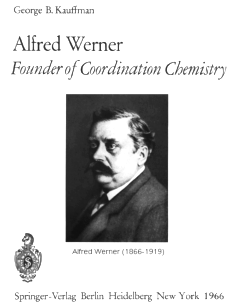Werner Complexes
The history of modern coordination chemistry has been the subject of several books, of
which perhaps the best known are those by George B. Kauffman. By necessity they all
highlight Alfred Werner, "the Father of Coordination Chemistry" who in 1893,
proposed the octahedral configuration of transition metal complexes and in 1913 received
the first Nobel prize in
Inorganic Chemistry.

In this series of experiments, some simple cobalt(III) complexes are to be prepared, which
show some of the properties that Werner was able to interpret using the octahedral model.
These include; optical, geometric and linkage isomerism.

Reaction Schemes as ISIS Draw .tgf file
Hexol.html
Kinetic Study
The nitrito isomer converts slowly at room temperature to the nitro isomer and the
conversion can be conveniently followed by observing the disappearance of the nitrito band
at approximately 1060 cm-1 in the IR spectrum.
Collect an IR spectrum of the penataamminechlorocobalt(III) chloride for comparison. The
pellet should be kept in a dessicator in the dark at room temperature between readings. At
the end of the experiment, the KBr pellet is placed in an oven at 100C to complete the
isomerisation and to obtain an A(infinity) measurement.
Plot a graph of log (A-Ainf) versus time. The rate constant k for isomerisation is equal
to 2.303*slope and the reaction is found to obey first-order kinetics.
References
"Classics in Coordination Chemistry - Part 1", G.B. Kauffman, Dover
Publications Inc., N.Y., 1968.
"Alfred Werner - Founder of Coordination Chemistry", G.B. Kauffman,
Springer-Verlag, Berlin, Heidelberg, New York, 1966.
"Inorganic Coordination Compounds", G.B. Kauffman, Heyden & Son, Ltd.,
London, Philadelphia, Rheine, 1981.
Cobalt(III) Ammines - "Werner" Complexes, A.M. Greenaway and R.J. Lancashire, J.
Chem. Educ., 1982, 59, 419-420.
Coordination Complexes of Cobalt, G.M. Williams, J. Olmsted III and A.P. Breksa III, J.
Chem. Educ., 1989, 66, 1043-1045.
The Resolution of a Completely Inorganic Coordination Compound, T. Yasui, T. Ama and G.B.
Kauffman, J. Chem. Educ., 1989, 66, 1045-1048.
 Return to Chemistry,
UWI-Mona, Home Page
Return to Chemistry,
UWI-Mona, Home Page
Dec-96, rjl


 Return to Chemistry,
UWI-Mona, Home Page
Return to Chemistry,
UWI-Mona, Home Page